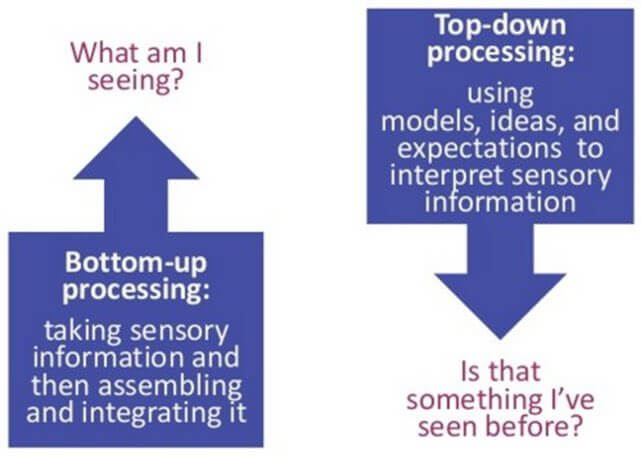Some Definitions
Sensation: the process by which our sensory organs receive stimulus energies from the environment and transduce them into the electrical energy of the nervous system
Transduction: the transformation of sensory stimulus energy form the environment into neural impulse
Perception: the neural processing of electrical signals to form an internal mental representation inside your brain of what’s on the outside
Processing Methods
We have a few techniques for dealing with sensation processing, namely:
Bottom Up Processing
Bottom Up Processing: processing that is driven by the physical features of the stimulus
Example
Bottom Up Processing Example: You see a new fruit for the first time. You notice its color, shape, and texture. You use these sensory details to identify it as a fruit you’ve never seen before.
Top Down Processing
Example
Have you ever woken up in the middle of the night and heard a noise, only to realize it’s just the wind? Your brain uses top-down processing to interpret the sound based on your prior knowledge and experiences.
Top Down Processing: processing that is driven by your prior knowledge, experiences, expectations, and motivations
You have conceptualized your world based on your experiences, and you use that to interpret new sensory information
In Laymanns Terms
Top Down is when perception is dictated by what you already know. Bottom Up is when perception is dictated by what you are currently sensing.

Thresholds of Awareness
Thresholds exist in our ability to perceive different stimuli, and reserachers attempt to determine them.
Psychophysics: The study of the relations between the physical characteristics of environmental stimuli and our mental experience of them.
Absolute Thresholds
Absolute Thresholds: the minimum amount of stimulation necessary for someone to detect a stimulus half of the time.
This is often measured in controlled lab settings, where researchers can manipulate the intensity of a stimulus and see if participants can detect it.
Just Noticeable Difference (JND)
The smallest difference between two stimuli that a person can detect half of the time. Unlike absolute thresholds, JNDs are relative to the intensity of the original stimulus.
Weber’s Law
Weber’s Law: The principle that the size of the JND is proportional to the intensity of the stimulus.
Adaptation
Adaptation: a decrease in sensitivity to a constant level of stimulation.
- Sensory adaptation occurs at the level of the sensory receptors.
- Perceptual adaptation occurs at the level of the brain.